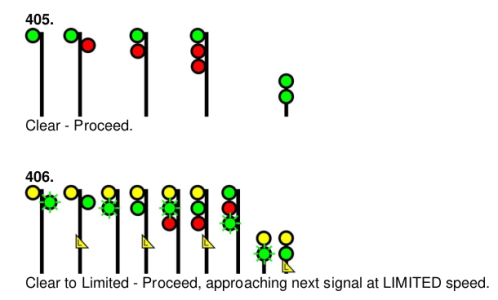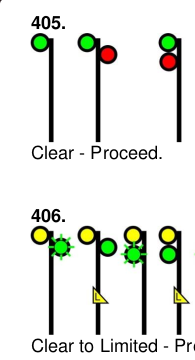You are using an out of date browser. It may not display this or other websites correctly.
You should upgrade or use an alternative browser.
You should upgrade or use an alternative browser.
Alternate mast position searchlight heads
- Thread starter chry-gmrs
- Start date
-
- Tags
- cpr searchlight
ModelRailroadForums.com is a free Model Railroad Discussion Forum and photo gallery. We cover all scales and sizes of model railroads. Online since 2002, it's one of the oldest and largest model railroad forums on the web. Whether you're a master model railroader or just getting started, you'll find something of interest here.
Staggered signals display a "Stop and Proceed" indication when all the lights are red. (Or "Restricting", if modified with a yellow "R" plate per Rule 436. Most intermediate signals these days have the R plates upgrading them so trains don't actually have to stop.)
In-line signals display a "Stop" indication when all red.
Staggered (Stop and Proceed) signals are intermediate/approach signals. In-line signals are the home signals for interlockings and control points.
In Canada, the offset of the heads is solely what indicates the signal is permissive (e.g. cannot show Stop Signal). For a one-head signal, an Ⓐ sign marks an absolute signal, and its absence marks a permissive signal.
In the United States, offset heads have historically been used to allow train crews to tell at a distance what type of signal it is, but cost-cutting has moved other devices such as number plates to be the more-common deciding factor. Since Canadian signals all display number plates, that scheme won't work there.
"A" plates are (only) used at passing sidings in ABS (APB).
Single head signals in general are far from rare. They show up everywhere as intermediate signals between control points in CTC or in ABS. Double head intermediates are only needed on the approach to interlockings or control points where signals can give reduced speed indications.
Affiliate Disclosure: We may receive a commision from some of the links and ads shown on this website (Learn More Here)
J.Albert
Well-Known Member
In the northern and eastern USA (may also be in other areas) "staggered" lights are used for automatic signals. Generally, the most restrictive indication they can display is "Stop and Proceed".
Vertical lights all aligned are used for interlocking signals. The most restrictive indication displayed by these is "Stop".
Not sure about Canada, but I wouldn't be surprised if this was standard practice up there as well.
Vertical lights all aligned are used for interlocking signals. The most restrictive indication displayed by these is "Stop".
Not sure about Canada, but I wouldn't be surprised if this was standard practice up there as well.
Snowman
Well-Known Member
On the D&RGW (and SP) the bottom head is often a "grade signal" and displays a "grade aspect."
The grade light is the same size as the others, but the background target is smaller than the three foot diameter standard interlocking--18"-24" as I recall, and it IS on the opposite side of the mast.
I only recall seeing them on single, intermediate signals, between interlocking/absolute/positive stop switches...and only on upgrade signals.
The D&RGW aspect is "lunar white," and it is very much a silvery grey color, not a normal white or soft white like an interior house bulb. It really does remind me of seeing a full moon through a light overcast.
[Not sure of the color aspect on the SP]
The purpose is to keep upgrade traffic flowing, and particularly in steep grade territory, to keep trains following other trains from having to stop and restart again...which can be very difficult even on dry rail.
When an upgrade train head end passes the signal, the color goes red, and when the tail end/caboose passes it too, the lunar white comes on, giving an indication of red-over-lunar white=grade permissive.
Paraphrasing mine: A train may pass the signal AT RESTRICTED SPEED without stopping, but being prepared to stop at any obstruction. The red tells the engineer of the following train that the block he's entering IS occupied, and on a dark, stormy and foggy night, you'd want an extra slice of caution...but if you could keep your train moving at even slow walking pace, it could be a big help. Restarting on wet, greasy rail can be a royal pain at times, I gather.
Note: This kind of slow uphill running is also where coupler strength and traction motor short-time ratings come into play too, so it can all get pretty interesting.
[Restricted speed aka yard speed is usually 15mph...but sometimes 10mph. Depends on the road]
The grade light is the same size as the others, but the background target is smaller than the three foot diameter standard interlocking--18"-24" as I recall, and it IS on the opposite side of the mast.
I only recall seeing them on single, intermediate signals, between interlocking/absolute/positive stop switches...and only on upgrade signals.
The D&RGW aspect is "lunar white," and it is very much a silvery grey color, not a normal white or soft white like an interior house bulb. It really does remind me of seeing a full moon through a light overcast.
[Not sure of the color aspect on the SP]
The purpose is to keep upgrade traffic flowing, and particularly in steep grade territory, to keep trains following other trains from having to stop and restart again...which can be very difficult even on dry rail.
When an upgrade train head end passes the signal, the color goes red, and when the tail end/caboose passes it too, the lunar white comes on, giving an indication of red-over-lunar white=grade permissive.
Paraphrasing mine: A train may pass the signal AT RESTRICTED SPEED without stopping, but being prepared to stop at any obstruction. The red tells the engineer of the following train that the block he's entering IS occupied, and on a dark, stormy and foggy night, you'd want an extra slice of caution...but if you could keep your train moving at even slow walking pace, it could be a big help. Restarting on wet, greasy rail can be a royal pain at times, I gather.
Note: This kind of slow uphill running is also where coupler strength and traction motor short-time ratings come into play too, so it can all get pretty interesting.
[Restricted speed aka yard speed is usually 15mph...but sometimes 10mph. Depends on the road]
Thanks, until someone comes up with another explanation, I'll go with that.In the northern and eastern USA (may also be in other areas) "staggered" lights are used for automatic signals.
Not sure about Canada, but I wouldn't be surprised if this was standard practice up there as well.
cv_acr
Well-Known Member
Compare the indications for Rule 439 "Stop" and Rule 437 "Stop and Proceed".CROR shows two head searchlights either both on the inside of the mast and with the bottom head on the outside of the mast.
When would the latter be used? An online search has so far come up empty.
Thanks, chry.
Staggered signals display a "Stop and Proceed" indication when all the lights are red. (Or "Restricting", if modified with a yellow "R" plate per Rule 436. Most intermediate signals these days have the R plates upgrading them so trains don't actually have to stop.)
In-line signals display a "Stop" indication when all red.
Staggered (Stop and Proceed) signals are intermediate/approach signals. In-line signals are the home signals for interlockings and control points.
Last edited:
JovetNE
New Member
This is exactly correct.Compare the indications for Rule 439 "Stop" and Rule 437 "Stop and Proceed".
Staggered signals display a "Stop and Proceed" indication when all the lights are red. (Or "Restricting", if modified with a yellow "R" plate per Rule 436. Most intermediate signals these days have the R plates upgrading them so trains don't actually have to stop.)
In-line signals display a "Stop" indication when all red.
Staggered (Stop and Proceed) signals are intermediate/approach signals. In-line signals are the home signals for interlockings and control points.
In Canada, the offset of the heads is solely what indicates the signal is permissive (e.g. cannot show Stop Signal). For a one-head signal, an Ⓐ sign marks an absolute signal, and its absence marks a permissive signal.
In the United States, offset heads have historically been used to allow train crews to tell at a distance what type of signal it is, but cost-cutting has moved other devices such as number plates to be the more-common deciding factor. Since Canadian signals all display number plates, that scheme won't work there.
Last edited:
cv_acr
Well-Known Member
For the rare one-head signal, an Ⓐ sign marks an absolute signal, and its absence marks a permissive signal.
"A" plates are (only) used at passing sidings in ABS (APB).
Single head signals in general are far from rare. They show up everywhere as intermediate signals between control points in CTC or in ABS. Double head intermediates are only needed on the approach to interlockings or control points where signals can give reduced speed indications.
JovetNE
New Member
Yeah, I didn't word that very well, and was being a bit "cheeky" on the use of "rare." I did not mean to imply 1-head signals themselves are not common, but that 1-head absolute signals are in the vast minority."A" plates are (only) used at passing sidings in ABS (APB).
Single head signals in general are far from rare. They show up everywhere as intermediate signals between control points in CTC or in ABS. Double head intermediates are only needed on the approach to interlockings or control points where signals can give reduced speed indications.
Affiliate Disclosure: We may receive a commision from some of the links and ads shown on this website (Learn More Here)



